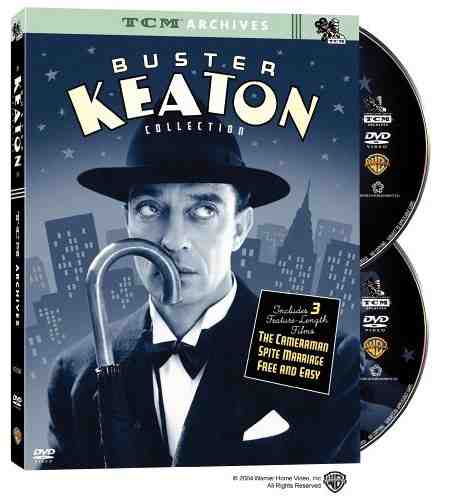Editorial Review of The Buster Keaton Collection, courtesy of Amazon.com
The Cameraman shows obvious and unfortunate signs of MGM’s insistence that Keaton, long accustomed to improvising scenes, conform to prepared shooting scripts. But it is less stifling than the second feature (Keaton’s last silent movie) in this set, the 1929 Spite Marriage, a slight farce about a pants-presser (Keaton) who borrows his customers’ fine threads to attend the theatre every night. There he worships an actress (Dorothy Sebastian) so furious with her caddish lover and co-star (Edward Earle) that she asks Keaton to marry her. The predictable results are unworthy of a Keaton film, but he does shine in several hilarious sequences, such as a disastrous turn as a bit player in his soon-to-be-wife’s stage dramas.
Finally, 1930’s Free and Easy, Keaton’s talkie debut, is a garish MGM valentine to itself, trotting out celebrity actors and directors (Lionel Barrymore, Cecil B. DeMille, Fred Niblo) in a wooden story set on a movie lot. But while Keaton struggles with dialogue and a script that frequently sidelines him, he has many good moments causing havoc on film sets. –Tom Keogh
Product Description of The Buster Keaton Collection
A two-disc DVD collection that spotlights the actor’s MGM period. “TCM Archives: The Buster Keaton Collection” features two of Keaton’s funniest silents, “The Cameraman,” re-mastered with a new score by former Frank Zappa band member Arthur Barrow, and “Spite Marriage” (featuring its original 1929 Vitaphone musical score) along with “Free and Easy,” Keaton’s first talkie. The DVD set also features film historian Kevin Brownlow’s poignant new documentary “So Funny It Hurt: Buster Keaton and MGM.”
Considered by many cinema’s greatest silent clown, Buster Keaton was a consummate practitioner of physical comedy whose career began in vaudeville at the age of three. Wearing trademark slapshoes and big baggy pants identical to his father’s, most gags involved pratfalls with his father kicking him across the stage or tossing him into the air. Within a few years of his debut, Keaton was scoring rave reviews which applauded the physical comedy that would come to be so much a part of his film fame. “The dexterity or expertness with which Joe Keaton handles ‘Buster’ is almost beyond belief of studied ‘business.’ The boy accomplishes everything attempted naturally, taking a dive into the backdrop that almost any comedy acrobat of more mature years could watch with profit” (Variety, March 12, 1910).
Details of The Buster Keaton Collection Films
The Cameraman – After becoming infatuated with a pretty office worker, Keaton sets out to become a newsreel cameraman in order to be closer to his dream girl. Keaton’s first film for MGM, made in 1928, is considered one of his funniest masterworks and offers up a feast of visual gags. The newly remastered DVD includes a new score by Arthur Barrow. Spite Marriage – In this 1929 silent laugh-filled classic, Keaton stars as Elmer, a man madly in love with stage star Trilbey Drew. When Trilbey’s boyfriend gets engaged to another woman, she marries Elmer in a desperate attempt to get even.
This was Keaton’s final silent comedy, and is presented here with its original Vitaphone music score. Free and Easy – In Keaton’s first talkie, he stars as an agent to beauty contest winner Elvira Plunkett. When Elvira decides to try her luck in Hollywood, Elmer goes along to help and the two soon find themselves falling in love. Chaos ensues when the couple must contend with Elvira’s disapproving mother and a handsome movie star, who also has his sights set on the lovely Elvira. This 1930 classic is highlighted by guest appearances from a host of other MGM stars of the era including Robert Montgomery and Lionel Barrymore.
